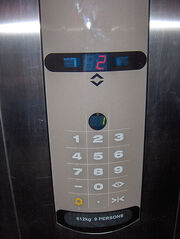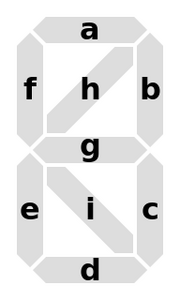
Elevator console
Lifts or elevators often indicate, both inside and next to doors, the direction they are moving and the floor they are currently at.

Since they usually can only go up and down
, a 3-segment display may be used for arrows.
| ↑ | ↓ | ^ | v | | | ◊ | ↕ | |
|---|---|---|---|---|---|---|---|
Different cultures, countries and languages have different ways to designate floors. Probably the most universal approach is to assign the ground level zero and count up from there, or down for underground floors. This requires an optional minus sign
in front of the digit
and additional digits are necessary
for skyscrapers; these can be combined with each other since there tend to be only few sub-levels
. A plus sign is redundant and is not possible with standard 7-segment displays.
If first letters are used instead, problems may arise.

K is efhi with this arrangement of 9 segments
In German, the ground floor is called Erdgeschoss , and Untergeschoss
may be used for basements (possibly followed by a digit
when it substitutes a minus sign), but Keller is preferred especially for single ones. Therefore, a German Aufzug ‘lift’ is not unlikely to employ a 9-segment display capable of displaying the letter K, if it does not use dot matrix displays of course. When there are only three floors – lower, main and upper Obergeschoss – there may be no digits at all:
,
,
– G representing Geschoss ‘floor’, although the French loan Etage is common elsewhere.